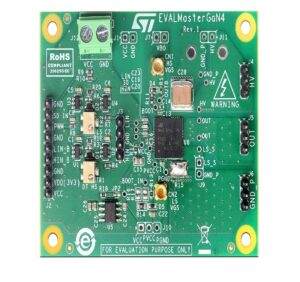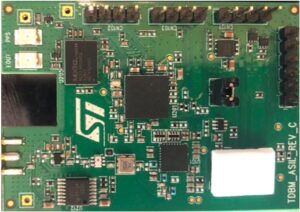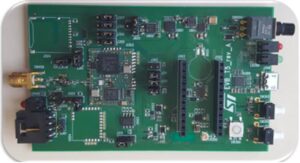Check out our presentations for electronica China 2021 on smart mobility, power and energy management, or IoT and 5G
To improve the accessibility of our content, please find the audio version of this blog post.
ST will take part in electronica China 2021 from April 14 to April 16, 2021. As the world continues to wrestle with a global pandemic, the event carries a special meaning. Indeed, it not only shows how far the industry has gone, despite worldwide disruptions, but it is also a testament to where it is going. Hence, ST will focus on three major categories of innovations. We will address smart mobility, power and energy management, as well as IoT and 5G. However, in preparation for the event, we wanted to highlight two major demos around gallium nitride and global positioning systems. Indeed, these innovations represent new solutions to complex challenges and show the upcoming trends that are shaping the industry.
electronica China 2021: Gallium Nitride Is Driving Efficiency
MASTERGAN4 and the Use of GaN in Fast Chargers

The event will serve as a platform for ST’s worldwide reveal and release of the MASTERGAN4 power device, the first MASTERGAN to have an RDS(on) of 225 mΩ at its high- and low-side. The component has a 600 V SiP half-bridge gate driver and a maximum drain current of 6.5 A. As a result, it can integrate power-conversion designs capable of reaching 200 W. Moreover, its performance-per-cost ratio makes it attractive to fast charger manufacturers looking to exploit gallium nitride’s properties. The announcement also heralds the coming of the EVALMASTERGAN4 demonstration board. Engineering teams looking to design a proof-of-concept rapidly can use the board as a reference design. Attendees will thus leave electronica China 2021 with the expertise and tools to start their GaN design.
MASTERGAN and the Importance of GaN in China
The MASTERGAN devices remain the only ones in the industry to house two E-mode GaN transistors and a gate driver in one package. ST released MASTERGAN1 in the fall of 2020 and MASTERGAN 2 soon after. MASTERGAN4 will now help manufacturers tailor their designs even further. Moreover, all the ST devices solve unique challenges that used to slow the democratization of Gallium Nitride. Indeed, thanks to their compactness and robustness, many in the industry are transitioning to the new material. Hence, the fact that ST is also announcing the availability of all MASTERGAN devices in China during the first half of 2021 is highly symbolic. Manufacturers now know that the design they are prototyping will hit markets quickly and in high volumes.
The news also comes on the heel of the newly released five-year plan, a Chinese government initiative that lists a series of macro-objectives in technology, economy, and more. One of these goals is the more prominent use of new materials, such as gallium nitride. Indeed, China is promoting innovations that will improve energy efficiency, increase its competitiveness, and help the environment. The MASTERGAN family thus represents a concrete solution at electronica China 2021 to meet these new objectives. Jodie Wang, Technical marketing manager, Power Discrete & Sub-Analog at ST, will also be giving a keynote presentation on MASTERGAN and Gallium Nitride to further equip attendees with the knowledge they will need to be part of China’s new push for greater energy efficiency.
electronica China 2021: Multi-band GNSS Receivers Are More Efficiently Driving
The New Accuracy Imperative

electronica China 2021 will serve to address the recent imperatives for greater accuracy in automotive. Indeed, with the rise of autonomous driving comes the need for global positioning systems with centimeter accuracy. Additionally, as China aims to sell the first Level 4 ADAS vehicle by 2025, it is imperative to have GNSS receivers compliant with the latest functional safety standards. The Advanced Driver Assistance System (ADAS) ranks the autonomy of vehicles with its level 0, establishing that there’s no autonomy at all while most cars today achieve a level 2. Level 4 is thus highly critical because it’s the step before an entirely autonomous vehicle (level 5). The main challenge is that more autonomy demands more precision, and currently, single-band GNSS receivers aren’t capable of it.
The First Triple Band GNSS Receivers and the First Functional Safety Qualification

Attendees at the event will see the solution to the accuracy challenge in the form of the TeseoV, and TeseoAPP, the only dual and triple-band global positioning receivers in the industry today. The demonstration is even more important as China is currently upgrading its constellation, Beidou, to increase accuracy. However, unless a receiver can support multiple bands, it cannot process the additional information. Moreover, the TeseoAPP is the only GNSS receiver already qualified for functional safety. Engineers looking to take advantage of these solutions will start with their evaluation boards. ST also worked with Quectel, who will show its LG69T, a production-ready module for the TeseoV. Finally, while the TeseoV is already ready for production, the TeseoAPP will be by mid-2021. Companies are, therefore, starting to design boards with these components to prepare for the next generation of vehicles.
